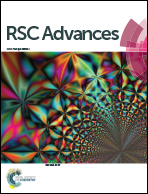Design and fabrication of a graphene/carbon nanotubes/activated carbon hybrid and its application for capacitive deionization
Abstract
In this work, graphene/carbon nanotubes (CNTs)/activated carbon (AC) (GTAC) hybrids were designed and fabricated by combing graphene, CNTs with AC into one new type of hybrid and applied as capacitive deionization (CDI) electrodes. The morphology, structure and electrochemical performance of the GTAC were characterized by scanning electron microscopy, nitrogen adsorption–desorption, cyclic voltammetry and electrochemical impedance spectroscopy. The results show that the GTAC with 72 wt% CNTs, 8 wt% graphene and 20 wt% AC exhibits the best electrochemical performance among all the samples. When used as a CDI electrode, GTAC exhibits a higher electrosorption capacity of 2.30 mg g−1 than those of optimized graphene/AC (1.10 mg g−1), graphene/CNTs (1.06 mg g−1) and CNTs/AC (0.96 mg g−1) in this work. The higher electrosorption capacity of GTAC can be ascribed to the superiority of the “plane-to-line-to-point” (graphene-to-CNTs-to-AC) conducting network. This result demonstrates that GTAC should be a promising candidate as a CDI electrode.


 Please wait while we load your content...
Please wait while we load your content...